This website breaks down how every game uses microtransactions
Microtransactions are impossible to avoid in games these days, whether you're playing the latest AAAs or some unknown free-to-play game.
But how every game implements monetisation systems varies greatly. It's not just what you can buy in each game that is different (cosmetic only or power), some games also have several forms of monetisation beyond the asking price.
Because of this, it can be a bit daunting to try and remember who does what. Fear not, though, because Microtransaction.zone (via PCGamesN) is a new site that aims to solve that problem.
The site's mission is simple: give readers a rundown of exactly what sort of monetisation scheme the games they're looking for have - at a glance. It does this through a number of badges and tags assigned to the various games included on its list.
For instance, if you type in "Battlefront 2" in the site's search bar, both the classic game and last year's DICE-made sequel will show up. The former has the Spotless tag, which means that you get all game content in the asking price.
EA's Star Wars, on the other hand, has the Bulk Horse Armour badge, meaning it has "excessive" amounts of minor DLC purchasable directly with no randomisation (there's another badge for loot boxes).
It also has the Infinite Money Hole tag to warn players that there's no upper limit to how much they can spend. Then there's the Table for One badge, to denote that extra monetised content is available only in multiplayer.
You can see even more of these tags on games like Call of Duty: WW2, which has practically every monetisation system known.
Check out the site for yourself at the links.









